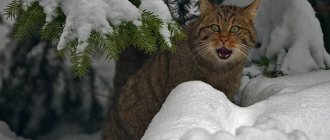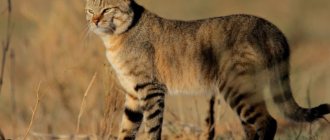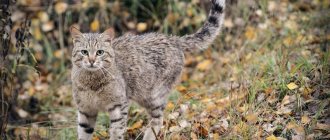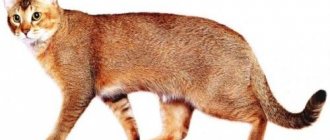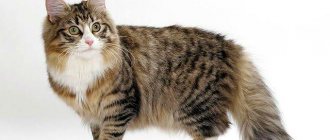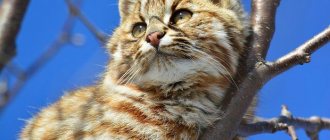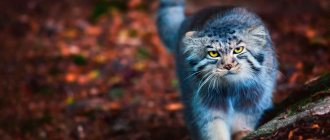Origin of the species and description
Photo: Forest cat
Wild cats belong to the group of predatory mammals. The main feature of this class of vertebrates is considered to be feeding their young with milk. The current number of predators of this species is about 5,500 species.
This number includes the cat family, the key features of which include:
- good adaptability to catching prey (animals quietly sneak up, and are also able to watch and pursue prey);
- a small number of teeth (compared to other representatives of predators, cats have only 28-30 teeth);
- a special coating of the tongue with pointed papillae (necessary not only for cleaning fur, but also for scraping meat from the bones of prey).
This particular genus of these individuals is referred to as “Cats”. This group includes representatives of small-sized cats. The most famous representatives of the class are the forest and domestic cats. At the same time, domesticated animals are considered by some scientists as a subspecies of wild ones. The division of cat lineages occurred more than 230 thousand years ago.
The group of forest cats has 22 species of representatives, of which 7 main ones:
- Central European (Felis silvestris silvestris);
- Caucasian (Felis silvestris caucasica);
- African (Felis silvestris cafra);
- Turkestan (Felis silvestris caudata);
- Omani (Felis silvestris gordoni);
- steppe (Felis silvestris lybica), subspecies – domestic (Félis silvestris cátus);
- Asian (Felis silvestris ornata).
Representatives of this class are found in many parts of the world. Their main range is Africa, Asia and Europe.
The history of the creation of this variety of phalaenopsis
The founders of the pedigree of this type of orchid are considered to be: the parent of the seed - Phalaenopsis Fantastic Mirage Tin-Fan Ho Ho, the parent of the pollen - Phalaenopsis Jiuhbao Red Rose Jiu Bao Biotech.
The ancestors of the Wild Cat grew in the mountain forests of the Philippines and on the Australian plains. Officially, this hybrid, obtained from crossing Phalaenopsis pleasant and Doritis most beautiful, was registered in 2008.
Appearance and features
Photo: What a forest cat looks like
In appearance, a wild cat can be easily confused with a short-haired pet. These are small animals, reaching no more than 7 kilograms in adulthood. The length of males reaches about 90 centimeters, females - no more than 75-80. They are distinguished from ordinary cats only by their slightly shortened paws and tail (at the same time, due to their characteristics, some specially bred breeds are practically indistinguishable from forest ones).
Video: Forest cat
A distinctive characteristic of wild individuals of the feline class is their rounded muzzle. She is special with her round eyes and erect triangular shaped ears. The mouth of cats is also unusual. Her teeth are smaller (than those of ordinary cats), but much sharper.
The animals' fur is short but thick. There are individuals of almost all shades of gray (dark, light, reddish). On the fur of most wild felines, transverse stripes are clearly visible, running along the entire body and tail (where they become especially clear). Molting occurs twice a year. On the tail the hair is much thicker and slightly longer. The tassels characteristic of some feline predators are absent. The paws of the animals are equipped with sharp retractable claws, which are the main weapon.
Description of the flower
The Wildcat flower has a standard butterfly-like shape for phalaenopsis: three sepals on the outside and three petals with a lip on the inside.
The petals are white-yellow with large and frequently spaced purple spots. The lip is dark purple with light yellow streaks.
Each peduncle produces 3–6 flowers up to 10 cm in size.
Where does the forest cat live?
Photo: European forest cat
Wild cats are quite common animals. They live in wooded areas of many continents.
The most favorite habitats of individuals are:
- Europe (mainly its Western and Central parts). You can meet animals in Spain and Italy. The range is limited to the north by England and the Baltic Sea;
- Caucasus. Cats also live on the northeastern border with some regions of the former Soviet Union;
- Asia. A greater concentration of animals is observed on the western peninsula of Asia Minor (or Anatolia).
These habitat regions of forest cats are still relevant today. In this case, they are supplemented by the southwestern regions of Ukraine, as well as Eastern Europe. Each representative of wild cats occupies its own territory for housing. Its area is about 2-3 kilometers (in the mountains this figure can be increased several times). Moreover, during the period of searching for a female, males can go much further than the boundaries of their territory. Animals choose mixed dense forests to live. The maximum height of the habitat is 2-3 kilometers above sea level.
Interesting fact: Wild cats are characterized by a hierarchical order of life. For the fertile area, where a large number of small mammals live, males fight “with their fists.”
Animals lead a predominantly solitary lifestyle. Pairing occurs only during the mating period. They try not to get close to human settlements. Low tree hollows act as shelters for wild cats (woody hollows used for breeding are covered with grass and leaves). Individuals living in the mountains prefer to hide in rock gorges, as well as old burrows of other animals. Moreover, if there is both a badger hole and a hollow at the same time, the cat will choose the first type of shelter.
Now you know where the wild forest cat lives. Let's see what he eats.
Wild cats
Wild Bengal cat - Felis bengalensis, Prionailurus bengalensis - is a beautiful cat of small size. Among cats, it is one of the most common. Habitat areas of the Bengal cat: Amur and Ussuri basins, Korea, Tsushima Islands, Manchuria, Hainan, Taiwan, Tibet, China, India from Kashmir and Southern Balochistan in the north to Tamil Nadu in the south, Thailand, Northern Vietnam, Indochina, Malacca, Kalimantan, Java , Bali, Sumatra, Philippine Islands. The weight of a Bengal cat is from 2.5 to 6.8 kilograms. It feeds mainly on voles, mice, squirrels, birds, and sometimes attacks hares, young roe deer and other animals that it can cope with. Does not disdain insects, reptiles, amphibians and fish.
The Far Eastern forest cat is much larger than a domestic cat. The body size of the Amur leopard cat is 75-90 centimeters, the tail is 35-37 centimeters; it has relatively long legs, a small head, and a thin tail. Distributed in the Far East, along the coast of the Sea of Japan and in the Amur River basin. The range of the Far Eastern forest cat extends across all of China, west to Hindustan and south to the Malay Archipelago. The Kalimantan cat - Catopuma Felis badia - is a rare, little-studied wild cat. She lives on the small island of Kalimantan, which belongs to Malaysia and Indonesia. Externally, the Kalimantan cat strongly resembles the Asian golden cat - Temminka. Weight is 2.3-4.5 kilograms. The body length of the Kalimantan cat is up to 80 centimeters. Golden cat (golden African cat) - Profelis aurata, Felis aurata - a large cat with a beautiful golden-brown coat. It lives in tropical rainforests, tall forests (from Senegal to northern Angola and from Congo in the west to southern Kenya in the east). It is also found on alpine heathlands. It rises into the mountains up to 3600 m above sea level. Its length is 72-94 cm. Weight is 11-14 kg. Snow leopard (irbis leopard) - Panthera unica - is a mammal of the cat family. This species occupies an intermediate position between large and small cats. The body length from head to tail is 100-150 cm, the tail length is 80-105 cm. The weight of an adult male is 40-45 kilograms, females - 35-40 kilograms. Iriomotean cat - Felis iriomotensis - Iriomotean cat - Japanese wild cat. Lives in the subtropical thickets of Iriomot Island. This island is located two hundred kilometers from Taiwan. The Iriomot cat was discovered by Japanese zoologist Yu. Imaitsumi in 1965. The length of the animal with a tail is 70-90 centimeters. The jungle cat - Felis chaus - swamp lynx, cat house - is distributed over a wide strip from Western and Minor Asia, Central Asia, Transcaucasia up to Hindustan, Indochina and South-West China. It is larger than other small cats. Nine of its varieties are known. The body length of the Hausa is 56-94 centimeters, the tail is up to 29 centimeters, and the ear height is up to 8.5 centimeters. The weight of a jungle cat is from 4 to 15 kilograms. The caracal or desert lynx - Felis caracal - is a medium-sized wild cat that resembles a lynx in appearance. The black-gray ears have noticeable black tufts like those of a lynx. The name of this wild cat comes from the Turkish language from the word “karakalak”, which translates as “black ear”. The caracal lives in the steppes and deserts of most of Africa and in the deserts of the Arabian Peninsula, in Central and Asia Minor, in the east to Western India. Along the coast of the Caspian Sea, the caracal's range reaches the Mangyshlak Peninsula, and in the east, the caracal is sometimes found in the Bukhara region of Uzbekistan. Caracals are found in small numbers in the deserts of Southern Turkmenistan. In nature, there are nine subspecies of caracal. Desert cat - Felis bieti. It is also called Gobi cat, Chinese cat. This species has been little studied. The desert cat is the only cat that is completely endemic to China, that is, this species is not found outside of China. The cat's weight is from 5 to 9 kilograms. The body length of the animal with tail is 98-140 centimeters. Geoffroy's cat - Felis geoffroyi - is a species of feline native to South America - the most common wild cat in South America. Geoffroy's cat got its name in honor of the French naturalist Geoffrey Saint-Hilaire, who described this species. Geoffroy's cat lives in forests and pampas in southern Brazil, Argentina, Paraguay, southern Patagonia, and Bolivia. Geoffroy's cat is found exclusively to the east of the Andes. The length of an adult animal is 45-75 centimeters, the length of the tail is additionally 25-35 centimeters. The weight of the animal ranges from 4.2 kg to 4.8 kg. Viverrid fishing cat - Felis viverrina. The fishing cat, wiverina, Asian fishing cat lives in humid jungles up to 1500 meters above sea level, mangrove coastal swamps, near rivers and streams. Its length reaches 95-120 cm.
The clouded leopard (Neofelis nebulosa) is a member of the cat family that lives in southeast Asia. It vaguely resembles a leopard and is considered a rather ancient species, as well as a possible ancestor of the current large cats. Body length is 69-108 cm, tail - 75-90 cm. Animal weight - 20-30 kg. Forest cat (lat. Felis silvestris). The forest cat or forest wild cat is common in the countries of Western Europe and Asia Minor, in the territory of Moldova, the Caucasus, and southern Ukraine. The body length of males is up to 90 cm, females - up to 70 cm. Depending on age and abundance of food, the weight of males reaches 7 kg, females - 5.8 kg. Pallas cat (Pallas cat, Latin Felis manul; synonym - Otocolobus manul) is a steppe cat that lives in the regions of Central Asia from the Caspian Sea to Transbaikalia, in Western China, Mongolia, Tibet, and Afghanistan. To date, this species has been little studied. In terms of size, the Pallas's cat does not differ much from the average domestic cat: the Pallas's body length is 52-65 cm, tail 23-31 cm; body height at withers 25 cm; ear width and height 5 cm; The length of the cat's skull is up to 9 cm, the width at the cheekbones is 7 cm. Margay, margi (lat. Leopardus wiedii or Felis wiedii) is a long-tailed American cat. It lives in moist, dense evergreen forests of South America all the way to Mexico. These are Panama, Ecuador, Guyana, Uruguay, Belize, northern Colombia, Peru, northern and eastern Paraguay, northern Argentina. The margay is a wild forest tree cat. He looks a lot like an ocelot. This is a small cat with a long tail, on high legs. The body length is 50-80 cm, the tail length is 30-40 cm. The cat's weight is 2.5-4 kg. Nzilla or tiger cat (Felis tigrinus) small spotted cat. Oncilla lives in tropical forests in northern South America and southern Central America, Brazil, Guyana, Argentina, Suriname, Venezuela, French Guiana, Peru, Colombia, Ecuador, Paraguay and Uruguay. Its length is 60-85 centimeters, oncilla is one of the smallest cats. Moreover, 25-40 centimeters are on the tail. The cat's weight is from 1.5 to 3 kilograms. Ocelot (lat. Felis pardalis). This is the most beautiful and largest of the wild American cats, except for the puma and jaguar. The ocelot lives in a large area of South and North America - from Southeast Brazil, Northern Argentina, Central Bolivia and Peru to the American states of Arizona and Arkansas. There are ten varieties of ocelot. The length of the ocelot reaches 80-130 cm, the length of the tail is 30-40 cm. The weight of the animal ranges from 7 to 14.5 kg. The Pampas cat (lat. Felis colocolo) or grass cat is a small cat from the Pampas regions of Argentina and Chile. It lives in the southern regions of South America - Argentina, Uruguay, Brazil, Chile, and the foothills of the Andes. Its weight is 3-7 kg. Body length - up to 76 cm. Tail length - up to 25 cm.
Puma (lat. Felis concolor) or cougar. This large American cat is also called a cougar, mountain lion. Found in southwest Alaska, Central Canada, USA, Central and South America. Fangs up to 4 cm in length. The puma weighs from 27 to 102 kg. The length of her body with tail is from 145 to 275 cm.
Dune cat (lat. Felis margarita). It is also called the desert cat or sand cat. This is a very unique and beautiful cat. Scientists discovered it twice. The North African species was described for the first time in 1858, and in 1926 the sand cat, living in the deserts of Kyzyl-Kuma and Kara-Kuma, was described. The sand cat is a small cat 73-91 cm long and weighing from 2 to 3.4 kg. Moreover, the length of the tail is 28-35 cm. Lynx (lat. Felis lynx) is the northernmost of the cat species. In many European countries it has been completely or almost completely exterminated. Nowadays it is found only in Russia, Finland, Poland, the Czech Republic, Hungary, Romania, Spain, Yugoslavia, Albania, Greece, and Ukraine in the Carpathians. The body is short, dense, 80-105 cm long. The weight of the animal is 8-15 kg. Serval (lat. Felis serval, Leptailurus serval) bush cat. The serval lives throughout Africa, excluding the Sahara and the extreme south of the continent. Its habitats are located north, south and east of the Sahara. Its body is approximately 90-135 cm long, its tail is 30-40 cm. Its weight ranges from 8 to 18 kilograms. Steppe cat - steppe cat - Felis lybica - or African wild cat. Distributed throughout Africa and in a wide area from the Mediterranean to China. Its body length is 63-70 cm, the cat weighs 3-8 kg. Has fully retractable claws. Her ears are big. The tail is long - 23-33 cm.
The Temminck is an Asian golden cat (lat. Catopuma temminckii) larger than the African golden cat. She is similar to a puma except for her coat color and size. The size of the animal depends on its habitat. The temminka is found in the territory from Nepal to Sumatra, in Southeast Tibet, China, Burma, Laos, and Vietnam. The cat weighs from 12 to 16 kg. Its body length is 66-105 cm. The black-footed cat is the smallest and lightest. Lives in southern Africa in the Kalahari Desert, Botswana and Namibia. It lives on open dry plains, steppes and savannas, in thickets of grass with scattered bushes. Its weight is 1-1.9 kg, the body length of males is up to 43-50 cm, females - up to 36 cm. Tail length is 15-22 cm. Jaguarundi (lat. Puma yaguarondi). The jaguarundi lives from the south of the United States to the north of Argentina: on the coast of Mexico, in Peru, Paraguay, in the south of Brazil. The body length of the jaguarundi is 55-70 cm, the tail length is 50-60 cm. The cat weighs from 4 to 8 kg.
What does a forest cat eat?
Photo: Wild forest cat
Cats obtain food by hunting smaller animals. The diet of forest predators largely depends on the season.
In good weather, the main prey of a feline hunter is considered to be:
- small animals (mice, squirrels, chipmunks, weasels, minks, etc.);
- amphibians and reptiles (frogs, snakes, lizards);
- fish (small representatives swimming mainly near the surface of the water);
- birds (and especially chicks or eggs left by winged parents in the nest).
Hunting cats give preference to those birds that live and nest on the ground.
Interesting fact: Particularly insightful and fearless representatives of wild cats are capable of killing a hare, roe deer or even a deer! True, this only happens when a large animal is already weakened and is not able to move quickly, or defend itself from cat attacks.
In winter, things are much worse with food. Due to heavy snow and frost, the number of birds is reduced, many animals prefer to hibernate or simply sit out in warm shelters, and fish hide under the crust of ice that covers the river. Hunting is very difficult. Cats have to track and wait for their prey for a long time. It is precisely because of the difficult hunting conditions in winter that the animals gain most of their weight in the summer. The accumulated fat allows them not to freeze and maintains the normal functioning of organs.
Interesting fact: Only in winter can felines approach human settlements. Here they brazenly steal chickens and other small livestock.
Wild cats hunt only at night. The best time to capture prey is sunset and dawn (between these events the animal sleeps in its shelter). Moreover, if it rains at night, the cat refuses to be hot.
Features of character and lifestyle
Photo: Amur forest cat
Forest cats are freedom-loving animals that prefer to live alone and do not tolerate competitors on their territory. They have a wary character and often show aggression towards other animals or approaching people (which can be noticed even when visiting a zoo).
Hissing at a person is typical even for those forest cats that they tried to tame. Animals cannot be trained, do not recognize people as heads of the house and, in principle, avoid all neighbors. You cannot have such a pet in a small apartment. He needs a large area - at least a dacha yard. It is worth considering that the animal loves to climb trees and inspect its possessions. There is no need to limit it in this regard.
However, it is likely that at the first opportunity the “domestic” pet will run away from its owners, preferring a wild lifestyle. Forest cats make sounds only during the mating season. In steely times they are very silent. Only occasionally from their “mouths” can one hear the whistling, hissing and howling that is characteristic only of them. All these sounds are produced by cats when aggression is shown towards them. Animals react very quickly. Perhaps this is due to excellent vision, developed hearing and a special sense of smell.
Social structure and reproduction
Photo: Far Eastern forest cat
Unlike domestic cats, forest cats mate only once a year and mainly between January and March. The female and male unite in a union only for the time of conception of offspring. Cats lure cats with a characteristic smell that spreads after the territory has been marked. The males responding to the scent begin a fierce fight among themselves.
The female allows only the strongest to approach her. The mating process takes place in a hollow tree (at a short distance from the ground) or in a hole abandoned by another animal. In this case, the mating site is arranged in advance for the young offspring. The “floor” is covered with leaves, grass and even bird feathers. After the kittens are conceived, the parents separate again. The expectant mother is left alone and awaits the birth of her offspring, taking care of them in advance. She arranges the home in the best possible way for childbirth.
Pregnancy of wild cats lasts for 2-4 months. At one time, a female is capable of giving birth to from 1 to 7 kittens. All cubs are born blind (sight comes only on the 9-12th day after birth) and helpless. They weigh only 250 grams and practically do not stand on their paws. They cannot do without maternal help in the first weeks of their life. The mother takes care of her cubs with love and reverence. It provides them with food and security. Only at one month do kittens begin to actively crawl. And already at 2, they go on their first hunt with their mother. Kittens that are more than 2 months old are very voracious. They are able to pet up to 7 mice a day, supplementing their diet with mother's milk.
Baby cats are very playful and inquisitive. They quickly move around their parent territory and move through the trees without fear. At the age of 5 months they set off into adulthood. The cats leave their mother's land and begin searching for their hunting territory. Cats remain within the mother’s area, but set up their own den. Sexual maturity of animals occurs at the age of 10 months.
Home care
In order for the Wild Cat to please the owner with its flowering, it is necessary to adhere to the basic maintenance recommendations:
- The place should be well lit, preferably with diffused sunlight. If necessary, the plant should be shaded.
- It is recommended to purchase a special substrate, which will contain pine bark, peat and moss. A glass or plastic container is suitable, allowing you to monitor the degree of humidity.
- In summer +25...+30 degrees is considered normal temperature, in winter – +20 degrees. Humidity required is 40–60%. It is not recommended to allow sudden temperature changes, low humidity and drafts.
- Watering is carried out as necessary, at least 2 times a week in summer, less often in winter. It is also recommended to periodically feed with special fertilizers during the growth period along with watering. Spraying is not recommended.
- Transplantation is carried out as needed (approximately once every 2 years). It is recommended to carefully remove the flower from the pot, inspect it, remove damaged parts and place it in a new container without watering it for several days.
- You can propagate in several ways. The first is for children. The children that appear on the peduncle must grow (roots up to 5 cm), and then they are carefully separated and planted separately. The second is by dividing the peduncle. After flowering, if there are buds on the peduncle, it is cut off and divided into parts (at least one bud per part) and placed in greenhouse conditions for rooting. The third is by division. A well-developed rosette is divided into parts, leaving 2-3 leaves on each, and planted in separate containers.
- Common diseases - gray mold and fusarium - are fought with fungicides, and thrips insects - with insecticides.
Find out interesting things about other groups and varieties of phalaenopsis: Big Lip, Golden, Stone Rose, Kimono, Cleopatra, Legato, Liodoro, Manhattan, Mix, Mini, Multiflora, Narbonne, Parrot, Ravello, Sogo, Surf Song, Frontera, Charmer, Chengdu, Schiller
Natural enemies of forest cats
Photo: Siberian forest cat
Forest cats are very dexterous and agile creatures. It is very difficult for other predators to hit them. Thanks to their ability to quickly jump from branch to branch (the length of the jump can be 3 meters), move through thickets and swim, felines easily hide from potential rivals. At the same time, the animals have enough enemies.
The main ones are:
- Foxes (dangerous for almost all species of forest cats, this is due to the expanded habitat of foxes);
- Jackals (they pose a threat to felines living in Southeast Europe and Asia);
- Martens (they hunt forest cats in the mixed forests of Asia and Europe);
- Lynx (such animals threaten mainly cats living in the northern hemisphere).
The main predator of forest cats (no matter how strange it may sound) are martens. Despite their significantly smaller size, they quickly infect young cats, contenting themselves with their meat.
Interesting fact: Despite the fact that jackals are considered enemies of forest cats, they themselves are afraid of these animals. When meeting a wild cat, the jackal will prefer to abandon the carrion it has caught, returning to eating it only after the animal has left.
Most cats become prey due to old age, illness or injury that limits normal movement. In standard situations, it is extremely difficult to catch up with the beast.
Population and species status
Photo: What a forest cat looks like
The exact number of forest cats in their natural habitat is unknown. This is explained by its constant change.
The animal population is declining for several reasons:
- Burning of forests (which occurs as a result of careless human actions);
- High level of garbage (because of it, smaller animals die, which cats feed on);
- Poaching (many hunters try to get a live wild cat in order to domesticate it).
The decline in the number of animals is also due to floods, as well as global climate changes, for which animals are not always prepared. It is worth noting that in some areas the wild cat population has been completely exterminated. Until 1927, two representatives of the cat class could be found in Belarus: lynxes and forest cats. Today, there are none left in this area. Zoologists consider human activity to be the main reason for the extermination of animals. The human desire to become the owner of a unique breed of cats or to enrich themselves by selling it has led to a sharp reduction in the number of representatives of this group in the natural environment.
Interesting fact: To restore the population of forest cats in Belarus, it was decided to purchase animals in Moldova for their further settlement in the state Polesie Nature Reserve.
If it were not for the illegal actions of people (pollution of nature, arson), the number of animals would be much higher. However, forest cats are not currently under serious threat. The only exception is one of the 22 existing species. We are talking about the Caucasian forest cat (Felis silvestris caucasica), listed in the Red Book in Russia.
Life in captivity
Since the wild forest cat is listed in the Red Book, its purchase and sale is illegal. Consequently, in captivity this wild cat can only be found in a zoo or nature reserve.
Conditions of detention
This exotic pet loves space, so it is better to keep it in a small fenced area or by setting up an enclosure. At the same time, you need to remember that the animal jumps 3 meters in length, so it is better to make the fence a little higher. The enclosure must have trees or logs for the pet to climb, as it did in the wild. In a zoo, the conditions for keeping an animal should be the same.
Of course, in a reserve, where an animal feels like in the wild, it lives better than in a zoo.
In captivity, cats reproduce well. Thanks to their maintenance in nature reserves and zoos, the population is preserved.
A forest cat's enclosure should contain trees or logs that it is used to climbing in the wild.
Caring for such a pet is not difficult - it is enough to comb the animal’s fur weekly and bathe it monthly (but this should not be done often). The wild forest cat does not like change, so “his things” do not need to be swapped. These animals are quite strong physically, but they still need to be visited by a veterinarian every six months, who will help eliminate the following diseases characteristic of the breed:
- hypertrophic cardiomyopathy (heart disease);
- polycystic kidney disease;
- retinal dysplasia.
It is not recommended to castrate or sterilize a wild pet, as it does not tolerate anesthesia well.
A friend of mine constantly sends photographs of her wild forest cat, since she lives far away and I have no opportunity to see the animal. A friend says that her pet’s character is not very flexible, but she attributes this feature to the animal’s wild nature. The girl says that, on the contrary, this suits her. A friend of hers bathes her pet quite rarely, and practically doesn’t care about its appearance at all, which is very convenient for her, since she, one might say, “lives” at work. And the cat, although with character, misses her, but lately he has become accustomed to this routine. The main problem is feeding the purr - my friend chose natural food for him, which has to be prepared in advance. Usually this takes up a decent part of the weekend, which, of course, makes the girl indignant. However, according to her, it’s worth it, because a real predator lives next to her. A friend arranged a special house for the animal, reminiscent of a small enclosure. Sometimes she lets the cat out for a walk around the outskirts of her property, but she is very afraid that the wild nature will overpower her love for her owner, and the pet will run away.
